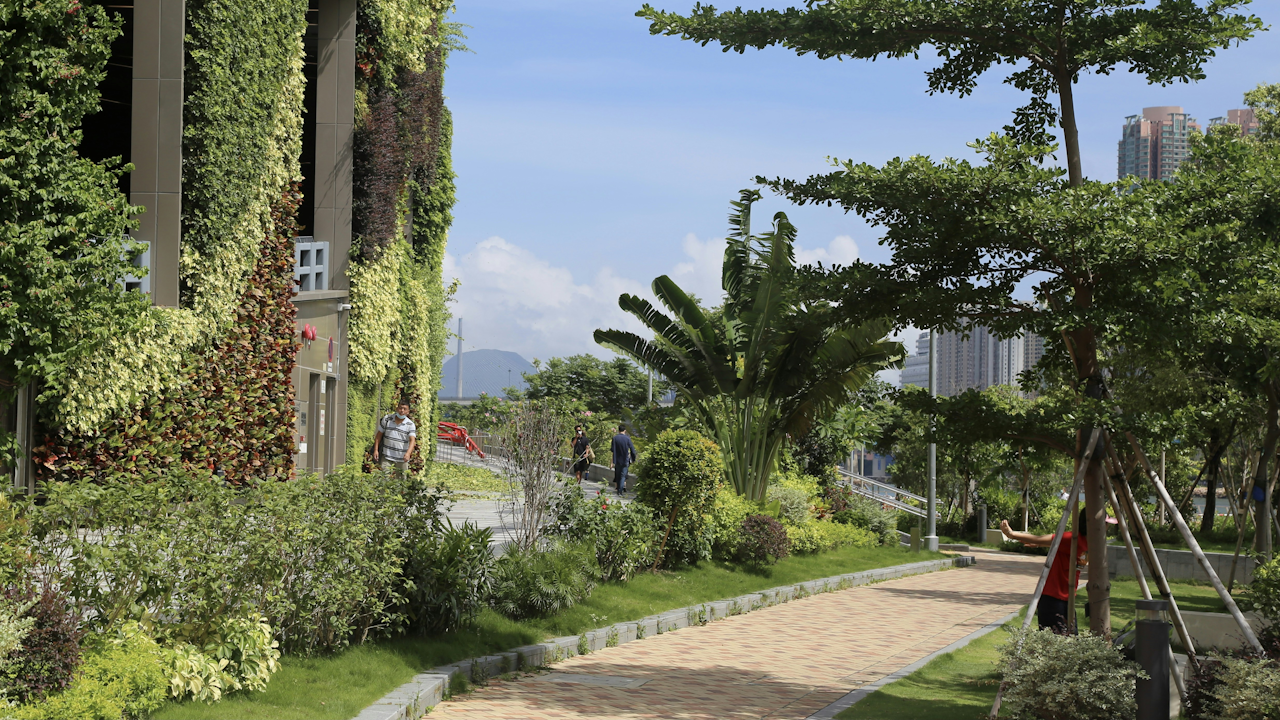Urbanization has led to significant environmental challenges, including air pollution, loss of biodiversity, and increased temperatures due to the heat island effect. To counter these issues, cities worldwide are adopting various strategies to introduce greenery into urban landscapes. These approaches enhance ecological balance, improve air quality, and contribute to overall well-being.
Green Roofs and Walls
One of the most effective strategies to incorporate greenery into urban settings is the adoption of green roofs and walls. Green roofs involve the installation of vegetation layers atop buildings, which help in reducing heat absorption, improving insulation, and managing stormwater runoff. Similarly, green walls—both living walls and green facades—allow for vertical gardening, enhancing biodiversity while also improving air quality. These solutions transform otherwise unused spaces into functional green areas that contribute to urban cooling and beautification.
Urban Reforestation and Street Trees
Planting trees along streets and in urban parks is a crucial step in mitigating air pollution and providing shade. Strategic placement of trees can reduce urban temperatures, lower energy consumption in buildings, and provide habitat for wildlife. Urban reforestation efforts focus on restoring native plant species and developing new green spaces in densely populated areas. Such initiatives help create carbon sinks, improve air quality, and enhance the aesthetic appeal of cities.
Pocket Parks and Green Corridors
Space constraints in cities often make large parks infeasible, but pocket parks and green corridors provide an alternative. Pocket parks are small green spaces developed within high-density areas, offering residents a natural retreat. These parks encourage social interactions and provide crucial ecological benefits. Green corridors, on the other hand, connect larger parks and green spaces, allowing wildlife movement and enhancing urban biodiversity. By integrating such corridors, cities create continuous green networks that improve air quality and recreational opportunities.
Sustainable Urban Agriculture
Urban farming has gained popularity as a means of improving food security while adding greenery to cities. Rooftop gardens, community farms, and hydroponic systems allow residents to grow fresh produce locally, reducing reliance on long-distance food transport and lowering carbon footprints. Community-driven urban agriculture initiatives also promote environmental education and foster stronger social bonds. Additionally, edible landscaping—where fruit trees and edible plants replace ornamental species—ensures that urban green spaces contribute both aesthetically and nutritionally.
Rain Gardens and Sustainable Drainage Systems
Water management is a key component of sustainable urban design. Rain gardens and bioswales help manage stormwater runoff by allowing rainwater to be absorbed into the soil rather than overwhelming drainage systems. These solutions reduce the risk of flooding, filter pollutants from rainwater, and provide attractive green spaces. Permeable pavements and urban wetlands complement these measures by ensuring that excess water is absorbed naturally, replenishing groundwater reserves and reducing strain on municipal infrastructure.
Integrating Green Spaces into Urban Planning
Effective urban planning plays a pivotal role in ensuring that cities remain green and livable. Zoning regulations should mandate the inclusion of green spaces in new developments, with specific requirements for tree planting, green roofs, and public parks. Mixed-use developments that integrate residential, commercial, and recreational areas encourage walkability and reduce reliance on vehicles, lowering overall emissions. Moreover, retrofitting existing infrastructure with green elements, such as converting abandoned lots into community gardens, can revitalize neglected spaces and bring nature closer to urban dwellers.
Public Transportation and Green Mobility
Reducing car dependency is another crucial aspect of greening urban areas. Expanding public transportation networks and investing in cycling infrastructure can significantly cut greenhouse gas emissions. Green mobility initiatives, such as tree-lined pedestrian pathways and bike-sharing programs, not only promote sustainable transport but also introduce greenery into urban settings. Encouraging the use of electric buses and trams further reduces air pollution, contributing to a healthier environment.
Incentives and Community Participation
Government policies and financial incentives can accelerate the adoption of green initiatives. Subsidies for green roofs, tax benefits for businesses implementing eco-friendly landscaping, and grants for community gardening projects encourage widespread participation. Additionally, engaging local communities in tree-planting drives and urban farming initiatives fosters a sense of ownership and responsibility. Public awareness campaigns highlighting the benefits of urban greenery ensure long-term commitment from residents and policymakers alike.
Smart Technology and Data-Driven Solutions
Advancements in technology offer innovative ways to optimize urban greening efforts. Smart sensors can monitor air quality, soil moisture, and temperature, providing data-driven insights to enhance green space management. Drones can be used for tree planting and monitoring vegetation health, while AI-driven modeling helps in planning green infrastructure. These technologies enable cities to implement targeted interventions, ensuring the sustainability of urban greenery initiatives.
Biodiversity Conservation in Urban Settings
Cities can play a significant role in conserving biodiversity by creating habitats for local flora and fauna. Designing parks with native plant species, installing birdhouses, and maintaining urban wetlands support wildlife populations. Pollinator-friendly initiatives, such as planting flowers that attract bees and butterflies, further enhance ecological balance. By prioritizing biodiversity, urban areas can become more resilient to climate change while fostering a harmonious coexistence between nature and human development.
Corporate and Institutional Responsibility
Businesses and institutions have a crucial role to play in urban greening. Corporate offices can incorporate green roofs, indoor plants, and nature-based workspaces to improve employee well-being. Schools and universities can implement green campus initiatives, incorporating tree planting and sustainable landscaping in their premises. Public-private partnerships can drive large-scale urban forestry projects, pooling resources for maximum environmental impact.
The Road Ahead
Greening urban areas requires a multi-faceted approach that integrates policy, technology, and community engagement. By embracing nature-based solutions, cities can mitigate climate change, improve air quality, and enhance quality of life for residents. Strategic planning and collective efforts will ensure that urban environments remain vibrant, sustainable, and resilient for future generations.

